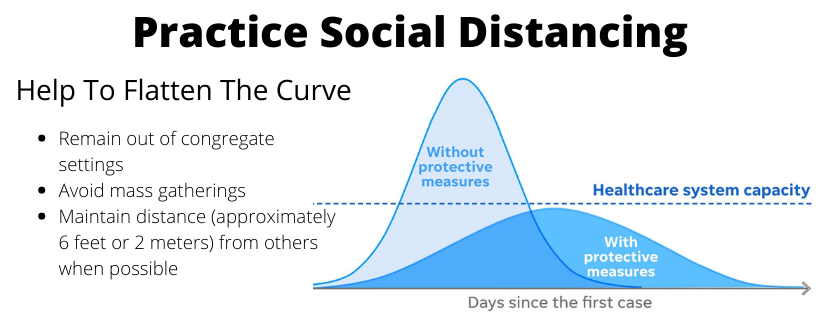To slow the spread of COVID-19 through U.S. communities, the U.S. Centers for Disease Control and Prevention has encouraged Americans to practice “social distancing” measures. But what is social distancing, and how is it practiced?
What is social distancing?
Social distancing is a public health practice that aims to prevent sick people from coming in close contact with healthy people in order to reduce opportunities for disease transmission. It can include large-scale measures like canceling group events or closing public spaces, as well as individual decisions such as avoiding crowds.
With COVID-19, the goal of social distancing right now is to slow down the outbreak in order to reduce the chance of infection among high-risk populations and to reduce the burden on health care systems and workers.
Why Is the CDC Recommending It?
According to the CDC, coronavirus is spread mainly through person-to-person contact. It’s believed that people who are in close contact (within 6 feet of one another) are most likely to spread it. It spreads through respiratory droplets that are produced when an infected person coughs or sneezes.
These droplets can land in the mouths or noses of anyone nearby and may be inhaled into the lungs, which can spread the disease.
And while it’s believed that people who are the sickest are most likely to spread coronavirus, some people might spread it before they begin to show symptoms. That’s why it may be important to practice social distancing even with people who don’t appear ill.
It may also be possible to contract COVID-19 through contaminated surfaces or objects. An individual who touches a surface that has the virus on it and then touches their own mouth or nose, for example, may contract the virus.
The CDC believes COVID-19 spreads easily throughout communities. So they have recommended social distancing as a way to help stop the spread.
If individuals reduce their contact with one another, people will be less likely to pass the virus on. This can be the best way to prevent what they refer to as “community spread.”
While the CDC isn’t recommending everyone take drastic measures like isolating themselves, they are advising people to take precautions, especially those who may be at a higher risk for contracting the disease.
Flattening the Curve
You may have seen references in the news or on social media to “flattening the curve” as a goal of social distancing. When new cases spike very quickly, hospitals and other medical facilities can be overwhelmed and unable to adequately treat everyone—including patients who are not actually dealing with the coronavirus. Such spikes are more likely when social distancing measures are not enacted quickly and early enough.
By slowing the number of new cases and stretching them out over a longer period of time—or “flattening the curve” of new cases—we can keep the number of total cases (and the number of high-risk cases) below that threshold, so that our hospitals have enough space and resources to operate as smoothly as possible during this difficult time.
How do I practice social distancing?
The CDC defines social distancing as it applies to COVID-19 as “remaining out of congregate settings, avoiding mass gatherings, and maintaining distance (approximately 6 feet or 2 meters) from others when possible.”
It’s particularly important—and perhaps obvious—to maintain that same 6-foot distance from anyone who is demonstrating signs of illness, including coughing, sneezing, or fever.
Along with physical distance, proper hand-washing is important for protecting not only yourself but others around you—because the virus can be spread even without symptoms.
The most obvious way to practice social distancing is to avoid crowded public places where close contact with others may occur. These might include movie theaters, religious gatherings, and crowded restaurants. Of course, it’s not always easy to practice social distancing.
Tips and Tricks
- Opt for online meetings rather than workplace gatherings whenever possible.
- Work from home if you can.
- Postpone major social gatherings.
- Consider video-chatting with friends and family rather than meeting in public places.
- Limit or postpone air travel and cruise ship travel.
- Stock up on vital items so you don’t have to go to stores as often.
- Order groceries from a delivery service.
- Shop online rather than in stores.
- Stay home if you are sick
On the broader scale, a number of actions taken in recent days are designed to encourage social distancing, including:
- Schools, colleges, and universities suspending in-person classes and converting to remote online instruction
- Cities canceling events, including sporting events, festivals, and parades
- Workplaces encouraging or mandating flexible work options, including telecommuting
- Organizations and businesses canceling large gatherings, including conferences
- Houses of worship suspending services
- Public and private libraries modifying their operations and restricting people from gathering by allowing people to come in only to pick up materials that have been reserved or requested on-line or by telephone

